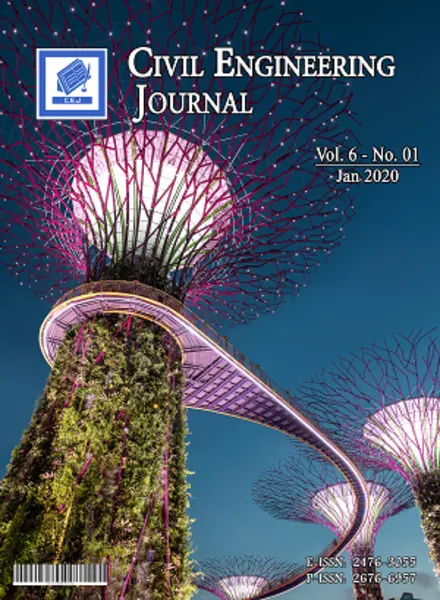-
performance of cement mortar exposed to different temperature and curing methods
جزئیات بیشتر مقاله- تاریخ ارائه: 1400/08/01
- تاریخ انتشار در تی پی بین: 1400/08/01
- تعداد بازدید: 500
- تعداد پرسش و پاسخ ها: 0
- شماره تماس ژورنال: 982188779475ext.258
performance of cement mortar exposed to different temperature and curing methods
curing is an important process to achieve the specified concrete strength and durability. the objectives here is to determine the effect of four curing regimes on the development of mechanical properties for mortar specimens with mix proportions of 1:2.75 cement to sand by mass with w/c of 0.46, and with standard cube and prism dimensions, using opc and srpc; specimens tested under curing temperatures at 25 °c and 45 °c; to simulate the seasonal climatic conditions in iraq. curing methods adopted were: 1st: immersion in water, 2nd: wetting by using saturated covers, 3rd: curing by using wax-based compound, and 4th: by air curing. the specimens were examined at the ages of 3, 7, 14, and 28 days for density and mechanical properties.
the study highlights that fully-saturated specimens in water is the recommended curing; as test results indicate that the highest mechanical properties were obtained. considering the compressive strength as the criterion, curing by using wax-based compound came 2nd; and curing by saturated covers in 3rd position. this is true for temperatures at 25 °c and 45 °c; however, the experiments carried on opc mortar show that increasing the temperature from 25 °c to 45 °c increases the early strength at 3 and 7 days by 16% and 22%, respectively; while the strengths at 14 and 28 days indicate an opposite manner; as the strength decreases when comparing the testing results at those ages by 23% and 17%. this is also valid for srpc mortar and water-immersion curing for the same temperatures and corresponding ages; 25% and 19% increase at 3 and 7 days, respectively; but the results show that there was a continuous increase in strength at 14 and 28 days, by 29% and 33%, respectively. the study points out that immersion-curing in high temperatures is not recommended for opc mortars after the age of 7 days; while it could be used for srpc mortars.
حوزه های تحت پوشش ژورنال
مقالات جدیدترین رویدادها
-
استفاده از تحلیل اهمیت-عملکرد در ارائه الگوی مدیریت خلاقیت سازمانی و ارائه راهکار جهت بهبود
-
بررسی تاثیر ارزش وجوه نقد مازاد بر ساختار سرمایه شرکت های پذیرفته شده در بورس اوراق بهادار تهران
-
بررسی تأثیر سطح افشای ریسک بر قرارداد بدهی شرکت های پذیرفته شده در بورس اوراق بهادار تهران
-
بررسی تأثیر رتبه بندی اعتباری مبتنی بر مدل امتیاز بازار نوظهور بر نقد شوندگی سهام با تأکید بر خصوصی سازی شرکت ها
-
تأثیر آمیخته بازاریابی پوشاک ایرانی بر تصویر ذهنی مشتری پوشاک ایرانی (هاکوپیان)
-
کمانش موضعی ورق های کامپوزیت لایه ای براساس تئوری زیگزاگ مرتبه بالا با استفاده از روش نوارهای محدود
-
بحران های زیست محیطی و معماری پایدار
-
بررسی استریولوژیکی تعداد گلومرول ها در نارسائی حاد کلیه ناشی از تجویز گلیسرول در موش صحرائی نر
-
بررسی اهداف تربیتی در سیستم نظام آموزشی کشور
-
coal induced production of a rhamnolipid biosurfactant by pseudomonas stutzeri, isolated from the formation water of jharia coalbed
مقالات جدیدترین ژورنال ها
-
مدیریت و بررسی افسردگی دانش آموزان دختر مقطع متوسطه دوم در دروان کرونا در شهرستان دزفول
-
مدیریت و بررسی خرد سیاسی در اندیشه ی فردوسی در ادب ایران
-
واکاوی و مدیریت توصیفی قلمدان(جاکلیدی)ضریح در موزه آستان قدس رضوی
-
بررسی تاثیر خلاقیت، دانش و انگیزه کارکنان بر پیشنهادات نوآورانه کارکنان ( مورد مطالعه: هتل های 3 و 4 ستاره استان کرمان)
-
بررسی تاثیر کیفیت سیستم های اطلاعاتی بر تصمیم گیری موفق در شرکتهای تولیدی استان اصفهان (مورد مطالعه: مدیران شرکتهای تولیدی استان اصفهان)
-
بررسی عوامل تأثیر گذار بر مزیت رقابتی دربین فروشگاه های زنجیره ای رفاه
-
کیفیت اطلاعات حسابداری و سودمندی تصمیم گیری گزارش مالی دولتی
-
شناخت نخبگان فکری و شیوه عمل آن ها در ایران پس از انقلاب
-
نظریه افتراق زنان و تحلیل آن در رمان هرس نوشته نسیم مرعشی
-
analysis and investigation of the relationship between the glass ceiling syndrome and organizational silence


سوال خود را در مورد این مقاله مطرح نمایید :